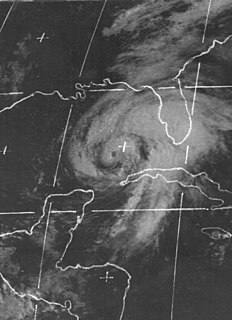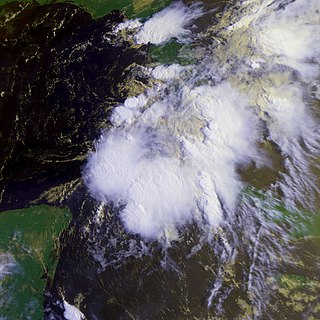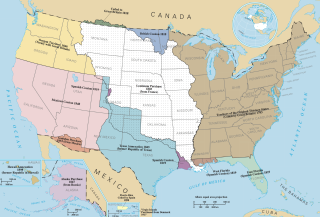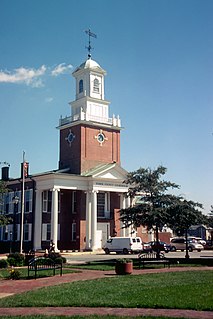
Hurricane Floyd was a very powerful Cape Verde hurricane which struck the east coast of the United States. It was the sixth named storm, fourth hurricane, and third major hurricane in the 1999 Atlantic hurricane season. Floyd triggered the fourth largest evacuation in US history when 2.6 million coastal residents of five states were ordered from their homes as it approached. The hurricane formed off the coast of Africa and lasted from September 7 to September 19, peaking in strength as a very strong Category 4 hurricane—just 2 mph short of the highest possible rating on the Saffir–Simpson Hurricane Scale. It was among the largest Atlantic hurricanes of its strength ever recorded.

Hurricane Agnes was the second tropical cyclone and first named storm of the 1972 Atlantic hurricane season. Agnes developed on June 14 from the interaction of a polar front and an upper trough over the Yucatán Peninsula. Initially forming as a tropical depression, the storm headed slowly eastward and emerged into the western Caribbean Sea on June 15. Once in the Caribbean, the depression began to strengthen, and by the following day, it became Tropical Storm Agnes. Thereafter, Agnes slowly curved northward and passed just west of Cuba on June 17. Early on June 18, the storm intensified enough to be upgraded to Hurricane Agnes. Heading northward, the hurricane eventually made landfall near Panama City, Florida late on June 19. After moving inland, Agnes rapidly weakened and was only a tropical depression when it entered Georgia. The weakening trend halted as the storm crossed over Georgia and into South Carolina. While over eastern North Carolina, Agnes re-strengthened into a tropical storm on June 21, as a result of baroclinic activity. Early the following day, the storm emerged into the Atlantic Ocean before re-curving northwestward and making landfall near New York City as a strong tropical storm. Agnes quickly became an extratropical cyclone on June 23, and tracked to the northwest of Great Britain, before being absorbed by another extratropical cyclone on July 6.

Hurricane Diane was the costliest Atlantic hurricane of its time, causing $813.7 million in damage. The inclusion of loss of business and personal revenue increased the total to over $1 billion. One of three hurricanes to hit North Carolina during the 1955 Atlantic hurricane season, it formed on August 7 from a tropical wave between the Lesser Antilles and Cape Verde. Diane initially moved west-northwestward with little change in its intensity, but began to strengthen rapidly after turning to the north-northeast. On August 12, the hurricane reached peak sustained winds of 105 mph (165 km/h), making it a Category 2 hurricane. Gradually weakening after veering back west, Diane made landfall near Wilmington, North Carolina, as a strong tropical storm on August 17, just five days after Hurricane Connie struck near the same area. Diane weakened further after moving inland, at which point the United States Weather Bureau noted a decreased threat of further destruction. The storm turned to the northeast, and warm waters from the Atlantic Ocean helped produce record rainfall across the northeastern United States. On August 19, Diane emerged into the Atlantic Ocean southeast of New York City, becoming extratropical two days later and completely dissipating by August 23.
The article covers the Hurricane Katrina effects by region, within the United States and Canada. The effects of Hurricane Katrina, in August 2005, were catastrophic and widespread. It was one of the deadliest natural disasters in U.S. history, leaving at least 1,836 people dead, and a further 135 missing. The storm was large and had an effect on several different areas of North America.

Tropical Storm Henri was a moderate tropical storm that formed in the 2003 Atlantic hurricane season. The eighth storm of the season, Henri was one of six tropical cyclones to hit the United States in the year. Henri formed from a tropical wave in the Gulf of Mexico in early September, and crossed over Florida as a tropical depression. Its remnants later moved into the Mid-Atlantic before dissipating completely.

Hurricane Ernesto was the costliest tropical cyclone of the 2006 Atlantic hurricane season. The sixth tropical storm and first hurricane of the season, Ernesto developed from a tropical wave on August 24 in the eastern Caribbean Sea. Ernesto first affected the northern Caribbean, reaching minimal hurricane status near Haiti before weakening and moving across eastern Cuba as a tropical storm. Despite initial predictions for it to track through the eastern Gulf of Mexico as a major hurricane, Ernesto moved across eastern Florida as a weak tropical storm. After turning to the northeast, it re-intensified and made landfall on August 31 on the North Carolina coast just below hurricane status. Late the next day, Ernesto became extratropical after entering southern Virginia. The remnants spread moisture across the northeastern United States before dissipating over eastern Canada on September 4.

The effects of Hurricane Isabel in Delaware resulted in one of only thirteen presidential disaster declarations for the state of Delaware. Hurricane Isabel formed from a tropical wave on September 6, 2003 in the tropical Atlantic Ocean. It moved northwestward, and within an environment of light wind shear and warm waters it steadily strengthened to reach peak winds of 165 mph (265 km/h) on September 11. After fluctuating in intensity for four days, Isabel gradually weakened and made landfall on the Outer Banks of North Carolina with winds of 105 mph (165 km/h) on September 18. It quickly weakened over land and became extratropical over Pennsylvania the next day. The storm's center remained to the south and west of Delaware, and was about 175 miles (280 km) from Delaware at its closest approach. At that time, Isabel was a strong tropical storm located in central Virginia.

The effects of Hurricane Isabel in Maryland and Washington, D.C., were among the most damaging from a tropical cyclone in the Baltimore-Washington Metropolitan Area, United States. Hurricane Isabel formed from a tropical wave on September 6, 2003, in the tropical Atlantic Ocean. It moved northwestward, and within an environment of light wind shear and warm waters, it steadily strengthened to reach peak winds of 165 mph (265 km/h) on September 11. After fluctuating in intensity for four days, Isabel gradually weakened and made landfall on the Outer Banks of North Carolina with winds of 105 mph (165 km/h) on September 18. It quickly weakened over land and became extratropical over western Pennsylvania the next day.

The effects of Hurricane Isabel in Virginia proved to be the costliest disaster in the history of Virginia. Hurricane Isabel formed from a tropical wave on September 6, 2003 in the tropical Atlantic Ocean. It moved northwestward, and within an environment of light wind shear and warm waters it steadily strengthened to reach peak winds of 265 km/h (165 mph) on September 11. After fluctuating in intensity for four days, Isabel gradually weakened and made landfall on the Outer Banks of North Carolina with winds of 165 km/h (105 mph) on September 18. It quickly weakened over land as it passed through central Virginia, and Isabel became extratropical over western Pennsylvania on September 19.

Tropical Depression One in June 1992 produced 100-year floods in portions of southwestern Florida. The first tropical depression and second tropical cyclone of the 1992 Atlantic hurricane season, the depression developed on June 25 from a tropical wave. Located in an environment of strong wind shear, much of the convection in the system was located well to the southeast of the poorly defined center of circulation. The depression moved northeastward and made landfall near Tampa, Florida on June 26 shortly before dissipating over land.

The June 2008 Midwestern United States floods were flooding events which affected portions of the Midwestern United States. After months of heavy precipitation, a number of rivers overflowed their banks for several weeks at a time and broke through levees at numerous locations. Flooding continued into July. States affected by the flooding included Illinois, Indiana, Iowa, Michigan, Minnesota, Missouri and Wisconsin. The American Red Cross assisted the victims of flooding and tornadoes across seven states and the National Guard was mobilized to assist in disaster relief and evacuation.

The effects of Hurricane Jeanne in the Mid-Atlantic region of the United States included two fatalities and $530 million in damage. Originating from a tropical wave off the coast of Africa in early September 2004, Hurricane Jeanne tracked through the Leeward Islands and Hispaniola for several days, resulting in extensive damage and an immense loss of life. After completing a clockwise loop between September 22 and 24, the storm intensified into a major hurricane before striking the Bahamas and Florida. Substantially weaker, the system turned northeastward over Georgia before affecting Delaware, District of Columbia, Maryland, New Jersey, New York, Pennsylvania, Virginia, and West Virginia; all of those states are in the Mid-Atlantic region of the United States. By the evening of September 26, the Hydrometeorological Prediction Center took over responsibility of monitoring the former hurricane over Virginia.

Tropical Storm Lee was the twelfth named storm and thirteenth system overall of the 2011 Atlantic hurricane season, developing from a broad tropical disturbance over the Gulf on September 1. It was designated as Tropical Storm Lee the next day. The system was rather large, and due to drifting, Lee brought flash flooding to the Gulf Coast. Flooding associated with the rains caused significant property damage in the areas, with drowning deaths reported in both Mississippi and Georgia. Elsewhere, the storm helped spread wildfires that destroyed homes and killed two people in Texas, and a traffic accident in Alabama resulted in one death. Rough surf offshore drowned one person in each of these states. Lee spawned 30 confirmed tornadoes in the United States. After becoming extratropical, Lee caused historic flooding in Pennsylvania, New York, and Canada, mainly Quebec and Ontario.

Hurricane Sandy was the deadliest and most destructive hurricane of the 2012 Atlantic hurricane season. Inflicting nearly $70 billion in damage, it was the second-costliest hurricane on record in the United States until surpassed by Hurricanes Harvey and Maria in 2017. The eighteenth named storm, tenth hurricane, and second major hurricane of the year, Sandy was a Category 3 storm at its peak intensity when it made landfall in Cuba. While it was a Category 2 hurricane off the coast of the Northeastern United States, the storm became the largest Atlantic hurricane on record. At least 233 people were killed along the path of the storm in eight countries.

Tropical Depression Six caused significant flooding along the Gulf Coast of the United States, especially in the Florida Panhandle. The sixth tropical cyclone of the 1975 Atlantic hurricane season, the depression developed from a trough of low pressure in the northeastern Gulf of Mexico on July 28. The system strengthened slightly, but peaked with maximum sustained winds of 35 mph (55 km/h) – below tropical storm intensity. Early on July 29, the depression made landfall in eastern Louisiana. Once inland, the depression slowly weakened and re-curved northeastward on July 30 into Mississippi, shortly before degenerating into a remnant low pressure area. The remnants moved through northern Louisiana and Arkansas until dissipating on August 3.

The effects of Hurricane Sandy in Maryland and Washington, D.C. included tropical storm force sustained winds with isolated gusts to hurricane force, plus significant mountain snow and coastal flooding.

The 1985 Election Day floods — also known as the Killer Floods of 1985 in West Virginia — produced the costliest floods in both West Virginia and Virginia in November 1985. The event occurred after Hurricane Juan, a tropical cyclone in the 1985 Atlantic hurricane season, meandered near the coast of Louisiana before striking just west of Pensacola, Florida late on October 31. Juan moved northward into Canada, but spawned another system that spread moderate rainfall across the Mid-Atlantic States, wetting soils. On November 3, a low pressure area developed south of Florida and moved northeastward along a cold front, bringing a plume of moisture influenced by Juan's previous track. The storm moved through the southeastern United States, stalling on November 5 west of Washington, D.C. before turning out to sea the next day. The event was known as the Election Day floods due to its concurrence with elections in Virginia.

The effects of Hurricane Floyd in Pennsylvania were concentrated in southeastern portions of the state, and included over a dozen deaths. Hurricane Floyd made landfall in North Carolina and, in a weakened state, impacted the Mid-Atlantic States with torrential rainfall. Over 10 in (250 mm) of rain in the state caused extensive and damaging flash flooding that affected over 10,000 homes. Many people became stranded due to the flood waters, and thousands had to be evacuated. Relatively strong winds resulted in widespread downed trees, some of which landed on houses and vehicles. Total preliminary damage from the storm was $60 million, and it is estimated that 13 people died due to the storm. Following the floods, multiple counties were declared major disaster areas.

Hurricane Floyd in 1999 was the costliest natural disaster in New Jersey's history, until it was surpassed by Hurricane Irene in 2011. Damage in the state totaled $250 million (1999 USD), much of it in Somerset and Bergen counties. Seven people died in New Jersey during Floyd's passage – six due to drowning, and one in a traffic accident. A police lieutenant took his life after coordinating floodwater rescues for nearly 48 hours.





































